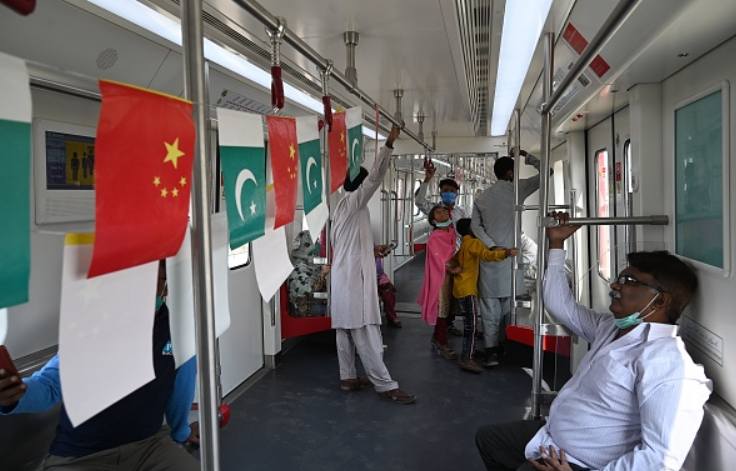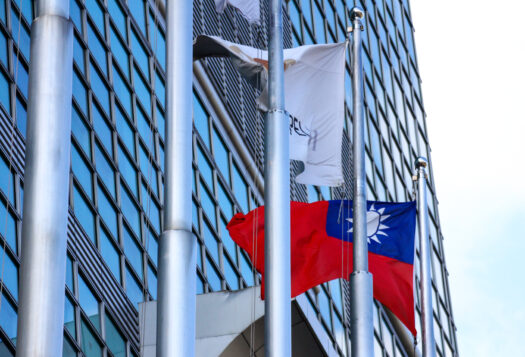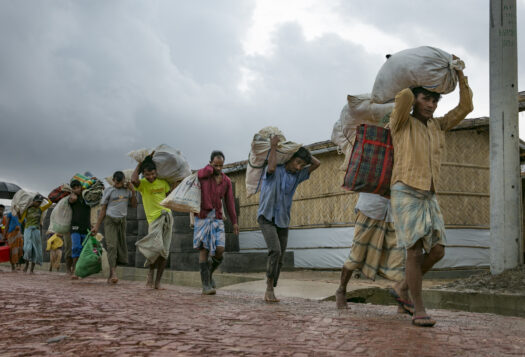
Pakistan is at the critical juncture of a localized poly-crisis. The country is experiencing political turmoil, environmental havoc, rising terrorism, and a burgeoning economic crisis. On the economic front, the country faces backbreaking inflation, a depreciating currency, and precariously low foreign exchange reserves. Moody’s Investor Service has spilled the trumpet of default in its latest report. Pakistan’s economic woes have triggered a tense debate over the cause of the crisis, as well as whether external partners could bail out cash-strapped Pakistan yet again.
As Pakistan struggles to address its deepening economic crisis, great power competition between the United States and China provides a geopolitical framing to the metastasizing economic situation in Islamabad. While U.S.-China competition has been a complicated challenge for Pakistan, the geopolitical use of the current economic crisis extends their competing efforts to influence Islamabad. As Beijing and Washington blame each other for the crisis, Pakistan finds itself in the crosshairs of their geopolitical competition to the detriment of a worsening economic crisis.
Pakistan: In the Crosshairs of U.S.-China Competition
Despite its strained relations with Pakistan, Washington is wary of Beijing’s growing influence in Islamabad. Although the Pakistani elite and public are seemingly optimistic about China’s greater role and investment, Western concerns nudge Pakistan into adopting a balanced approach between China and the United States.
While the U.S.-China competition has been a complicated challenge for Pakistan, the geopolitical use of the current economic crisis extends their competing efforts to influence Islamabad.
On his visit to Islamabad, U.S. State Department Counselor Chollet Derek expressed Washington’s concerns over Chinese debt to Pakistan and the “perils” of their bilateral relationship. The Chinese Foreign Ministry responded that the financial policies of the “western-dominated financial creditors” and a “certain developed country” are behind the economic difficulties of developing countries, including Pakistan – a veiled slight toward the United States.
This is not the first time Pakistan has been mired in a diplomatic spat between the United States and China. Last year, U.S. Secretary of State Antony Blinken sought Chinese debt restructuring for Pakistan amid the devastating floods. The Chinese Foreign Ministry warned Washington against “unwarranted criticism” of China-Pakistan cooperation, calling for the United States to do something “real and beneficial” for the Pakistani people. Previously, the United States warned Pakistan against using the IMF money to pay Chinese debt, broadly stemming from Washington’s criticism of the China-Pakistan Economic Corridor (CPEC).
China has announced additional loans to Pakistan amidst a deadlock with the IMF. However, Beijing is unlikely to consider debt restructuring during the ongoing political uncertainty in Islamabad. On a question about whether China will roll over Pakistan’s $7 billion debt due by June, the Chinese Foreign Ministry repeated the clichés of an “all-weather strategic and cooperative” partnership between the two “iron brothers,” leaving specifics about debt roll-over to the “competent Chinese authorities.” In fact, China has already expressed its reservations about the overdue payment of $1.5 billion to the CPEC-installed independent power plants (IPPs).
The China Factor in Pakistan’s Economic Crisis
China has been Pakistan’s key economic partner by providing multi-billion inflows through CPEC as its flagship Belt and Road Initiative (BRI) project. While CPEC is celebrated as the economic “game changer” in Islamabad, Washington has criticized the project for leaving unsustainable debt to Pakistan. Currently, as Pakistan’s economic crisis worsens, critics, especially in the Western capitals, blame the Chinese debt in Pakistan. According to an IMF report, Islamabad owes 30 percent of its total $100 billion external debt to Beijing.

While Pakistan’s economic crisis is not a direct function of China, the rising debt around Chinese projects without generating foreign exchange has added to the country’s economic woes. The fact is that a crippling economic crisis besets Pakistan even after almost a decade since CPEC was launched. A domestic debate has surged over whether the China factor is a reality behind Pakistan’s economic woes. Maleeha Lodhi, who served twice as Pakistan’s ambassador to the United States, argues that many of the country’s problems are of its own making, as the privileged elite has overlooked public interest and pushed the country to the brink. Miftah Ismail, Pakistan’s former finance minister, dismissed the notion of blaming China or the IMF for the crisis and called for domestic structural reforms.
U.S.-China Competition as the External Agency in Pakistan’s Economic Crisis
As the U.S.-China competition intensifies, relations with great powers have become a greater bone in Pakistan’s domestic politics. Over the last few years, progress over CPEC has slowed down, while relations with the United States—which turned frosty under the previous Imran Khan’s government—have gained momentum with frequent bilateral interactions. Last year in June, as has been the case in the current economic crisis, Pakistan sought Washington’s help for a bailout package from the IMF after China refused to provide additional financial support.
While relations with the United States are accounted generally for security convergences in Afghanistan, Washington remains Pakistan’s primary trade partner. In March 2022, the two countries relaunched the Trade and Investment Framework Agreement (TIFA) to expand bilateral economic cooperation. Despite China becoming the most active investor in Pakistan in recent years, the United States is Pakistan’s largest export destination, with a trade surplus of $2.1 billion. However, despite criticism of Chinese investment, Washington has lagged in incentivizing private investment in Pakistan or offering an alternative to Chinese infrastructure development.
The enduring costs of more than $150 billion incurred by Pakistan in partnering with the U.S. war on terror dominate the debate about Washington’s role in Pakistan’s economy. Apart from the direct financial costs of counter-terrorism operations, it has slowed down economic activity in Pakistan by creating a non-conducive business environment and blocking Foreign Direct Investment (FDI). Economically vital projects under CPEC are at severe security risk from hostile groups due to Pakistan’s role as a front-line state against the War on Terror.
China has been celebrated as Pakistan’s most favorable economic partner and the largest source of foreign direct investment. However, while China may be extending financial loans to Pakistan in difficult times, its support has less been “all-weather” when it comes to the question of debt restructuring or the burgeoning trade deficit – resulting from the Free Trade Agreements (FTAs) that benefit China more than they add value to Pakistani exports. Notwithstanding its “all-weather” friendship, China did not oppose India’s move to exclude Pakistan from the BRICS Summit, which included other emerging economies.
Looking Ahead
While Pakistan’s economic crisis is caused primarily by its domestic inability to enact structural economic reforms, China and the United States also share part of the burden. While China can be blamed for a huge trade imbalance and rising debt, the U.S.-led war-on-terror in Afghanistan, and the resulting instability rendered havoc for Pakistan’s economy. That said, Beijing and Washington have shared interests in helping Islamabad offset destabilizing impacts of the ongoing economic, security, environmental, and political crises.
Although progress over CPEC may be slow, there is little reason to doubt the resilience of China-Pakistan relations in the long run relative to an otherwise historically transactional relationship with the United States.
The geopolitical spat between China and the United States over Pakistan’s economic crisis is motivated by their competition to drive out each other’s influence from third countries. Although progress over CPEC may be slow, there is little reason to doubt the resilience of China-Pakistan relations in the long run relative to an otherwise historically transactional relationship with the United States.
As Pakistan grapples with the worsening economic crisis, it is imperative for Islamabad to navigate through the intensifying U.S.-China competition without having to evoke unbearable economic or security risks.
***
Click here to read this article in Urdu.
Image 1: Asim Hafeez/Bloomberg via Getty Images
Image 2: Arif Ali/AFP via Getty Images


